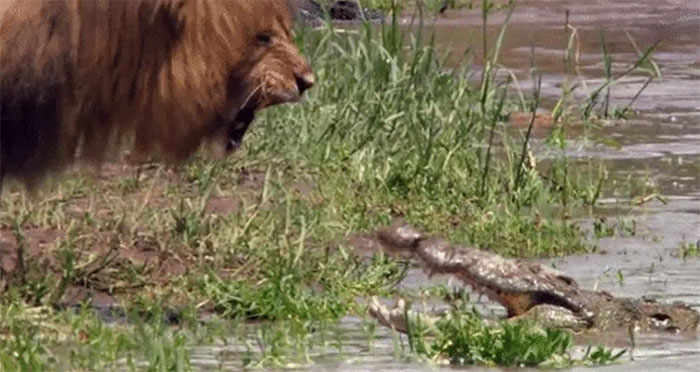A Lucky Male Lion Chases Away a Pack of Aggressive Crocodiles. If a confrontation occurs, it would be very difficult for it to survive against these cold-blooded hunters in the water.
Crocodiles and Lions are two species that often come into conflict as they frequently steal each other’s prey or even attack one another. However, it is very rare for a confrontation to end in a peaceful resolution, as seen in the clip below.
Shared by the Disneynature channel, the clip shows an adult Nile crocodile appearing threatening with its wide-open mouth, approaching a male lion.
Immediately, the lion, with its claws and fangs ready for an attack, stands its ground. The crocodile is equally fierce, opening its mouth wide and swinging its massive tail in a threatening manner. Behind it are at least three other crocodiles also ready to charge ashore to “devour” their enemy.
Clearly, while lions may “reign supreme” on the savannah, when faced with crocodiles, animals known for their extremely powerful bites, lions must tread carefully.
Nevertheless, in this encounter, the lion emerged victorious. The roar and ferocity of the lion frightened the crocodile, causing it to retreat into the water, and the surrounding crocodiles quickly gave up.

The determination and strength of the lion make the crocodile hesitate.
In nature, crocodiles and lions frequently steal each other’s prey when the opportunity arises. Lions are known to be able to kill crocodiles that come onto land, while the reverse often occurs for lions if they venture into the water. Evidence of this is that lion claws are occasionally found inside the stomachs of crocodiles.
Dubbed the “king of all beasts”, lions have an astonishing bite force of up to 457,000 kg/m² (1000 PSI), equivalent to 1,700N. However, this figure pales in comparison to that of crocodiles, the reptiles known as the “kings” of deadly bites.
Specifically, with a terrifying bite force of up to 2.6 million kg/m², the African crocodile ranks at the top of the list of animals with the most powerful bites. Typically, a single bite from a crocodile can crush bones, significantly limiting the movement of its target.
Even less dangerous crocodile species, such as the estuarine crocodile or the saltwater crocodile, possess an average bite force of 5000 PSI – five times that of an adult lion.
Usually, after delivering its devastating bite, a crocodile will pull its victim down into the river to drown it. Then, to tear apart its prey, the crocodile clamps down on the flesh and spins multiple times to rip the meat away.
At first glance, one might think this is impossible due to the lack of leverage, but for crocodiles, this is not difficult at all. As soon as they catch a whiff of blood, five or six crocodiles will swim over, eager to share the meal. As a result, the prey is torn into hundreds of pieces by their powerful jaws and violent spinning.
This shows that the male lion in the clip above was truly fortunate to chase away the pack of crocodiles from their meal, because if a confrontation had occurred, the lion would have found it very difficult to survive against these cold-blooded hunters in the water.


















































